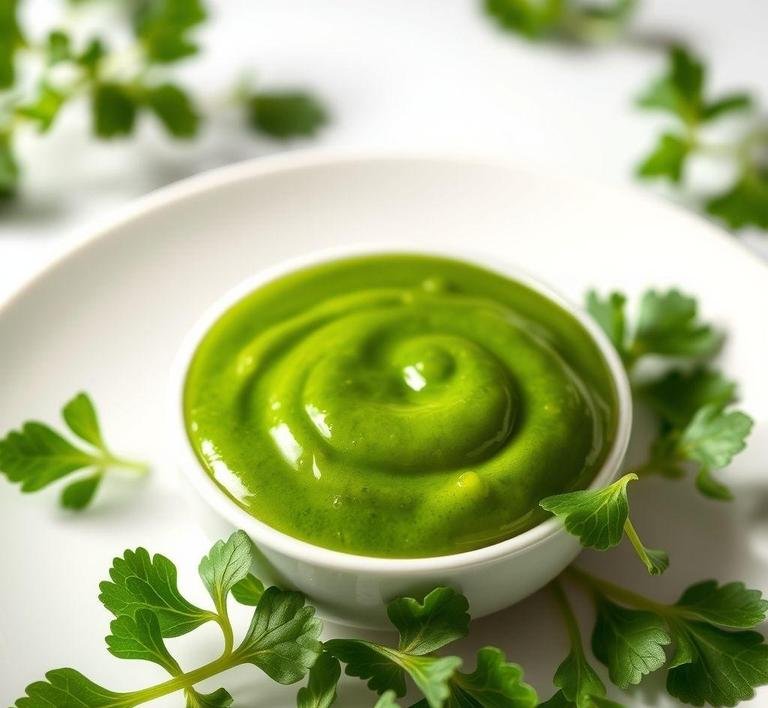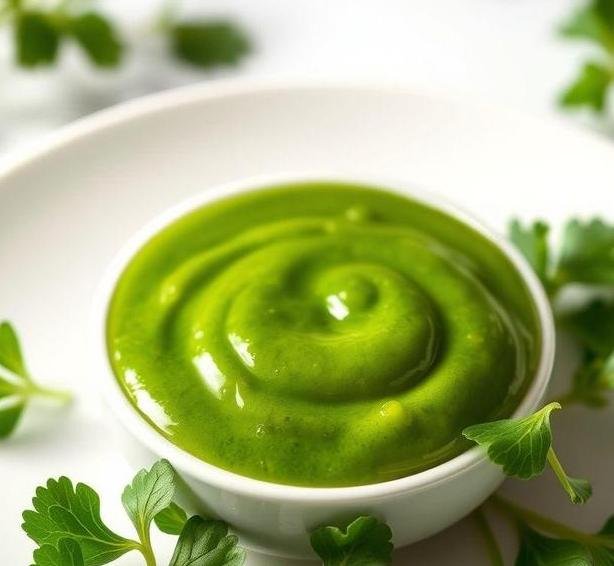Mary Berry, a culinary icon in the UK, has a reputation for creating simple, yet incredibly flavorful dishes that bring out the natural goodness of ingredients. One of her more intriguing recipes is her Watercress Sauce, which is a fresh, vibrant accompaniment that adds a zingy, peppery depth to a variety of dishes. The sauce is a versatile, herb-infused creation that uses watercress-an often underappreciated leafy green-as the star ingredient.
Watercress itself is a nutrient-dense plant with a distinct peppery flavor, making it an ideal base for a sauce that cuts through rich meats or creamy dishes. Mary Berry’s version of this sauce elevates its natural taste, balancing the sharpness of the watercress with creamy undertones, and often a touch of tangy acidity, making it perfect for serving with grilled fish, roasted meats, or even simply drizzled over fresh vegetables. It’s a delightful way to make a dish feel lighter yet still packed with flavor, giving your meal a sense of sophistication with minimal effort.
The watercress sauce is ideal for those who want to bring a bit of springtime freshness to their cooking. It’s vibrant in both color and flavor, giving an otherwise basic meal an exciting punch. Whether you’re entertaining guests or preparing a simple family dinner, this sauce can make all the difference in elevating the dish to a new level.
Mary Berry’s Watercress Sauce Recipe
Ingredients Needed

The ingredients for Mary Berry’s Watercress Sauce are simple, but together, they create a balanced, flavorful result. Here’s what you’ll need:
- Watercress (fresh): The star ingredient, watercress, brings a peppery, sharp flavor that’s both vibrant and earthy. You’ll need a generous bunch of fresh watercress-about 100g, ideally. You can find it in most grocery stores or farmers’ markets.
- Butter: For a creamy and rich texture, butter is essential. It helps to mellow the intensity of the watercress while adding a lovely smoothness to the sauce.
- Double Cream: This ingredient adds richness and depth, creating a velvety texture. Double cream, known for its higher fat content, helps balance out the peppery bite of the watercress and ensures the sauce has a luxurious finish.
- Lemon Juice: A small squeeze of lemon juice will bring in some acidity and brightness. The citrus enhances the pepperiness of the watercress while cutting through the richness of the butter and cream.
- Vegetable or Chicken Stock: This helps to add depth and body to the sauce without overpowering the fresh flavors of the watercress. Using a good quality stock (homemade, if possible) can elevate the sauce significantly.
- Seasoning (Salt and Pepper): Like any good sauce, the right balance of seasoning is essential. You’ll need just enough salt to bring out the flavors of the ingredients and a few cracks of black pepper to complement the peppery bite of the watercress.
Optional:
- Garlic: Some versions of this sauce incorporate a small amount of garlic for added complexity, though Mary Berry’s classic recipe sticks to the essentials.
Equipment Needed
This recipe doesn’t require any special or complicated tools, making it perfect for those who like to keep their kitchen minimal. Here’s a list of what you’ll need:
- Saucepan: A medium-sized saucepan is ideal for cooking the sauce. You’ll need it to heat the stock, melt the butter, and bring everything together.
- Blender or Hand Blender: To achieve the smooth consistency that Mary Berry’s sauce is known for, a blender (either a countertop blender or an immersion hand blender) is necessary to purée the cooked watercress. This step ensures a creamy, lump-free sauce.
- Knife and Chopping Board: For chopping the watercress and any additional ingredients like garlic, a sharp knife and a clean chopping board are needed.
- Ladle or Spoon: To serve the sauce or drizzle it over your dishes, a ladle or large spoon will be handy.
- Measuring Cups/Spoons: While the recipe doesn’t call for exact measurements, having a set of measuring spoons and cups can help you achieve the right balance of stock, cream, and lemon juice.
Instructions To Make Mary Berry’s Watercress Sauce
Making Mary Berry’s Watercress Sauce is simple and quick, but it results in a sophisticated flavor that will wow your guests. Here’s how to make it:
- Prepare the Watercress: Start by washing the watercress thoroughly under cold water. You want to remove any grit or dirt. Once cleaned, roughly chop the watercress, removing any tough stems.
- Cook the Stock: In a medium saucepan, heat the vegetable or chicken stock over a medium heat. Bring it to a gentle simmer, allowing it to reduce slightly. This adds concentrated flavor to your sauce.
- Sauté the Watercress: In a separate pan, melt the butter over medium heat. Once the butter has melted, add the chopped watercress and cook for 1-2 minutes. This will wilt the leaves and soften their peppery flavor, allowing them to blend seamlessly into the sauce.
- Add Cream and Stock: Pour the simmering stock into the pan with the watercress and butter. Add the double cream and stir everything together. Let it cook for a further 3-4 minutes, stirring occasionally. This helps thicken the sauce and brings all the flavors together.
- Blend the Sauce: Once everything is combined and cooked down a little, remove the pan from the heat. Use an immersion blender or transfer the mixture to a countertop blender. Blend until smooth and creamy, ensuring there are no large chunks of watercress left.
- Finish the Sauce: Return the smooth sauce to the heat and stir in the fresh lemon juice. Season with salt and pepper to taste, adjusting the acidity or salt levels as needed.
- Serve: Once the sauce is at the desired consistency and flavor, it’s ready to serve. Drizzle it over your main dish, whether it be grilled fish, roast chicken, or even steamed vegetables.
Tips And Tricks
- Adjust the Thickness: If you prefer a thinner sauce, you can add a bit more stock or even a splash of water to thin it out. For a richer, creamier sauce, increase the amount of double cream or butter.
- Substitute Cream: For a lighter version, you can substitute double cream with single cream or even Greek yogurt. However, this will alter the richness of the sauce.
- Stock Matters: The quality of the stock is essential in creating a flavorful base. Homemade stock will give the sauce a much deeper, more nuanced taste compared to store-bought options. If using a store-bought stock cube, opt for a low-sodium version to avoid making the sauce too salty.
- Flavor Variations: If you want to add more layers of flavor, consider adding a clove of garlic or a few sprigs of thyme when sautéing the watercress. A dash of white wine or a splash of vinegar can also brighten the sauce, especially when using it with heartier dishes.
- Serving Ideas: While Mary Berry’s Watercress Sauce is perfect with fish and meat, you can also drizzle it over roasted vegetables, scrambled eggs, or even pasta for an extra burst of flavor.
Mary Berry’s Watercress Sauce is a testament to the power of fresh, simple ingredients. With just a handful of elements-watercress, butter, cream, and a bit of stock-you can create a rich, vibrant sauce that transforms any meal into something special. The peppery bite of watercress pairs beautifully with the smooth creaminess of the sauce, offering a perfect balance of richness and freshness. Whether you’re serving it with a Sunday roast or a light fish dish, this sauce adds a burst of color and flavor that will delight your taste buds.
Best of all, it’s quick and easy to make, so you don’t need to be a seasoned chef to whip up something that feels elegant and impressive. It’s the perfect way to showcase seasonal ingredients and add a little gourmet flair to your meals.
Easy Recipe Variations For Mary Berry’s Watercress Sauce

Mary Berry’s watercress sauce is a wonderfully fresh, peppery, and slightly tangy addition to any dish. While her original recipe is elegant in its simplicity, there are numerous ways to give it a twist or tailor it to your specific tastes or dietary needs. Here are some easy variations to experiment with, each one bringing something new to the table.
1. Creamy Watercress Sauce:
For a richer, more indulgent version of Mary Berry’s watercress sauce, you can incorporate cream into the base. Add a generous splash of heavy cream or crème fraîche to the sauce once the watercress has been blitzed. This will create a silky, creamy consistency, perfect for pairing with roasted meats or even as a dip for crispy potatoes. If you’re looking to reduce the fat content, a lower-fat alternative like Greek yogurt can work as a substitute, offering the same creaminess with a slightly tangy undertone.
2. Nutty Watercress Sauce:
A nutty twist adds depth to the sauce’s flavor profile. Simply toast a small handful of pine nuts or almonds in a dry pan and add them to the sauce mixture after the watercress has been blended. The nuts add an earthy texture that complements the peppery greens, balancing the flavor and creating a heartier option for pairing with grilled vegetables or a quinoa salad.
3. Citrus-Infused Watercress Sauce:
For those who enjoy a bright, zesty flavor, adding a splash of citrus to the watercress sauce can elevate it. Fresh lemon juice, lime zest, or even a dash of orange juice can bring an exciting contrast to the herbal base of the watercress. This citrus variation is particularly refreshing when served alongside seafood dishes, such as poached salmon or grilled shrimp, where the acidity cuts through the richness of the proteins.
4. Vegan Watercress Sauce:
To make the sauce vegan-friendly, you can simply substitute any dairy products with plant-based alternatives. Use almond milk or oat milk instead of cream, and replace butter with olive oil or a plant-based butter. Additionally, nutritional yeast can be added to lend a cheesy, umami flavor without any animal-derived ingredients. This vegan version works beautifully with roasted vegetables or a hearty grain-based salad.
5. Garlic and Herb Watercress Sauce:
For those who enjoy a more aromatic version of the sauce, adding garlic and other herbs can create a richer, more complex profile. Sauté a small clove of garlic in butter or olive oil until fragrant, then stir into the blended watercress sauce. You could also experiment by adding a handful of parsley, basil, or thyme for an herbal punch that makes the sauce perfect for pasta, chicken, or even as a topping for a baked potato.
6. Spicy Watercress Sauce:
For a kick of heat, incorporating some chili peppers can be a game-changer. Whether you use fresh green chilies, red chili flakes, or a drizzle of sriracha sauce, the addition of spice can completely transform the flavor. This spicy variation works wonderfully with grilled meats like steak, pork, or even spicy tofu for a bold, unexpected pairing.
7. Cheesy Watercress Sauce:
If you’re a fan of cheesy sauces, a sprinkling of grated Parmesan or Gruyère can take this simple watercress sauce to the next level. Stir the cheese into the sauce once it has been blended for a rich, velvety texture. This is particularly good when paired with pastas, risottos, or roasted vegetables.
By varying the ingredients or introducing new flavors, Mary Berry’s watercress sauce becomes a versatile component in your culinary repertoire, adaptable for any meal or occasion.
Storing Leftovers
After you’ve enjoyed your meal, you might be left with some of Mary Berry’s delicious watercress sauce. Don’t let it go to waste! Storing leftovers properly ensures you can enjoy this vibrant sauce for another day.
Refrigeration:
If you plan to keep the sauce for a short period, simply transfer any leftovers into an airtight container and store it in the fridge. It should stay fresh for up to 3-4 days. Before serving it again, give the sauce a good stir, as the texture may slightly change after it has been refrigerated. You may want to thin it out with a little extra cream, milk, or water if it’s too thick.
Freezing:
For longer storage, freezing is an excellent option. To freeze the sauce, allow it to cool completely, then pour it into a freezer-safe container or freezer bag. Make sure to leave some space at the top of the container for expansion. The sauce will keep well for up to 3 months. When you’re ready to use it, thaw it in the fridge overnight, and reheat gently on the stove. Be aware that freezing may alter the texture slightly, especially if the sauce contains dairy, so it might separate a little once reheated. A quick stir should bring it back together.
Tip for Smooth Reheating:
When reheating the sauce, do so slowly over low heat to prevent curdling or splitting, especially if it’s a creamy version. Adding a splash of water, milk, or broth while heating can help bring the sauce back to its original smooth consistency.
What To Eat With Mary Berry’s Watercress Sauce?
Mary Berry’s watercress sauce is wonderfully versatile, lending itself to a wide variety of pairings. Here are some delicious ideas for what to serve it with:
1. Grilled Meats:
The fresh, peppery bite of the watercress sauce is an excellent complement to grilled meats such as chicken, lamb, or beef. It pairs especially well with roasted or grilled chicken breasts, lamb chops, and even a juicy steak, where the sauce acts as a refreshing contrast to the savory meat.
2. Fish and Seafood:
Fish dishes, particularly those with delicate flavors, are perfect for pairing with this vibrant sauce. Try it with salmon, sea bass, or cod-whether pan-seared, baked, or poached. The freshness of the watercress sauce elevates the fish, adding a layer of brightness without overwhelming its delicate taste. You can also drizzle it over a seafood medley, such as prawns, scallops, or mussels.
3. Vegetables:
Watercress sauce works beautifully with roasted, steamed, or sautéed vegetables. Consider pairing it with roasted asparagus, broccoli, cauliflower, or Brussels sprouts. For a more hearty vegetable dish, it also works wonderfully with mashed potatoes or even a veggie burger, where the creamy sauce adds richness and balance.
4. Pasta:
A drizzle of watercress sauce can transform a simple pasta dish. Toss it through freshly cooked pasta for a light, herbaceous sauce that’s not too heavy. You could add grilled chicken or sautéed mushrooms for a more filling meal. For an extra touch, sprinkle some Parmesan or crumbled goat cheese over the top.
5. Eggs:
Eggs are another great pairing with Mary Berry’s watercress sauce. It can be spooned over poached eggs, scrambled eggs, or even an omelet. The sauce brings an elegant, slightly peppery note that’s perfect for breakfast or brunch.
6. Potato Dishes:
Potatoes, whether mashed, roasted, or even in a salad, work wonderfully with the sharpness of the watercress sauce. Try it as a topping for crispy roasted potatoes or mix it into a creamy potato salad for an extra layer of flavor.
7. Sandwiches & Wraps:
Watercress sauce can also be used as a spread in sandwiches or wraps. Try it in a turkey or chicken sandwich, alongside fresh greens and crisp vegetables, or as a dipping sauce for crispy vegetable wraps.
Conclusion
Mary Berry’s watercress sauce is a wonderfully adaptable and flavorful creation that can elevate so many dishes with its peppery freshness and smooth, creamy texture. Whether you’re sticking with the classic recipe or trying out some of the easy variations, this sauce adds a burst of brightness to everything from meats and seafood to vegetables and pasta. By storing leftovers properly, you can savor this sauce for days to come, adding a touch of gourmet to even the simplest meals. Whether you drizzle it over a juicy steak, spoon it onto grilled vegetables, or toss it through your pasta, Mary Berry’s watercress sauce proves itself as an essential recipe in your culinary repertoire.
FAQs
What Are The Key Ingredients For Mary Berry’s Watercress Sauce?
Mary Berry’s watercress sauce recipe primarily calls for fresh watercress, butter, cream, and vegetable stock. The watercress is blended to create a smooth, flavorful base, while the butter and cream add richness. Vegetable stock is used to enhance the flavor without overpowering the delicate taste of the watercress. Seasoning with salt and pepper helps to balance the flavors.
How Do I Prepare Mary Berry’s Watercress Sauce?
To prepare Mary Berry’s watercress sauce, first, wash the watercress thoroughly. Then, melt the butter in a pan over medium heat. Add the vegetable stock and bring it to a gentle simmer. Once the stock is heated, add the watercress and let it wilt for a few minutes. Afterward, add the cream and continue to cook for a few minutes until it thickens. Finally, blend the sauce until smooth and season with salt and pepper to taste.
What Dishes Can I Pair Mary Berry’s Watercress Sauce With?
Mary Berry’s watercress sauce is incredibly versatile and can complement a variety of dishes. It’s an excellent accompaniment for grilled or roasted meats like chicken, lamb, or fish. The fresh, peppery flavor of the watercress sauce also pairs beautifully with poached eggs or as a topping for roasted vegetables. For a more sophisticated dish, you can drizzle it over a steak or serve it with a creamy pasta for added richness.


